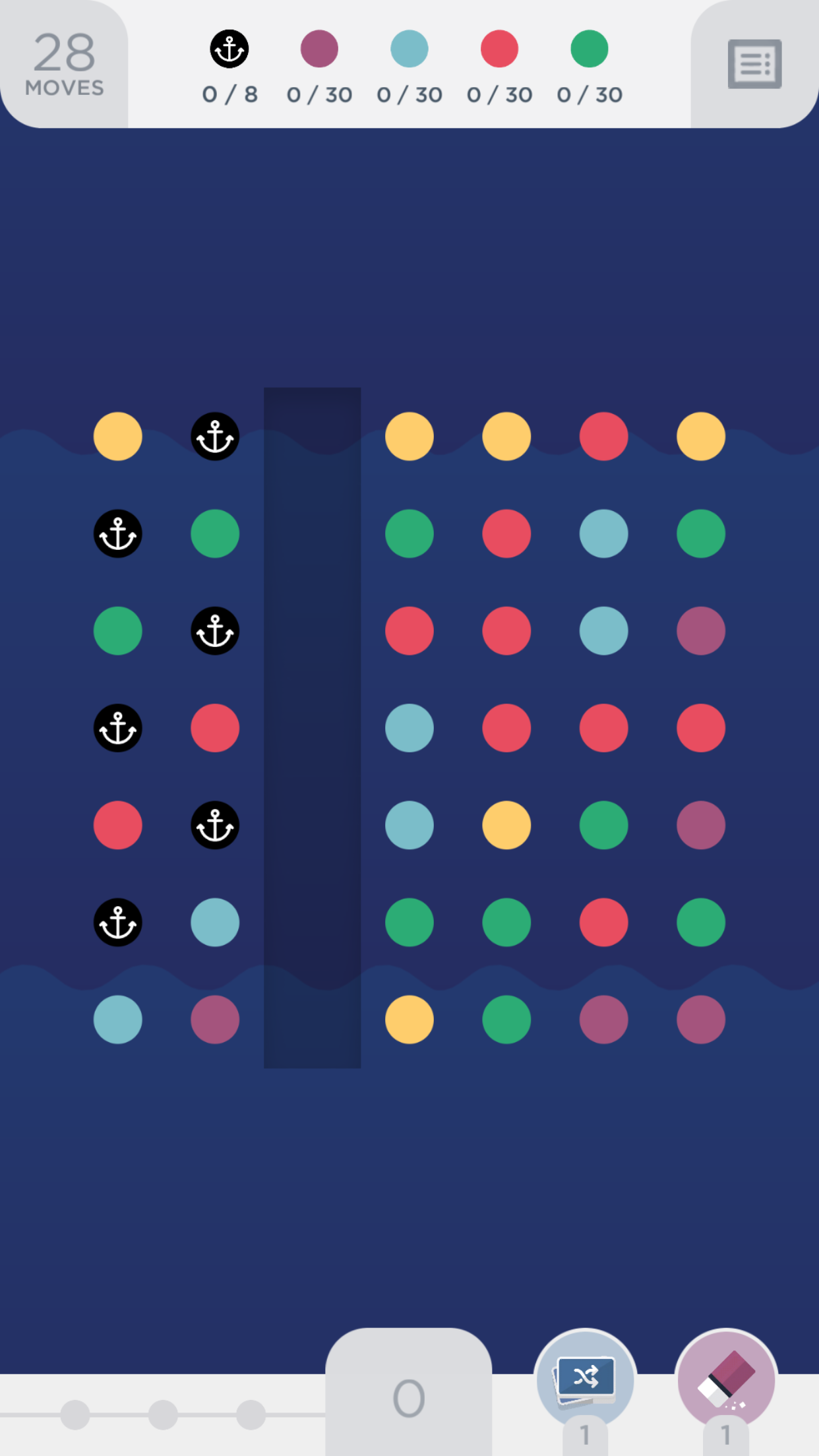Rayman Fiesta Run is a runner which feels like a party. Today we’ll brush over a few of the game features, but instead of looking at the individual levels, I want to dive deep into the hidden upsell system in play.
How it works:
In a nut shell, Rayman is running full speed through the level. Players can make him jump, attack, or hover for a short time. That’s it. Their primary goal is to get him to the flag at the end while collecting as many Lums (Think generic collectable/currency) as they can along the way.
At roughly 1, 25, 50 and 75 Lums collected, upon completing the level, the player will free a captured Teensy. Teensys are used to progress through the game.
Look at the charm. The Teensy is in a cage and still smiling and happy. The other three are literally dancing.
A player must rescue a certain amount to unlock the next group of levels. If a player collects all 100 Lums in any main line level (level unlocked via rescuing Teensys), then a harder version of the same level will be unlocked for the player to challenge.
On the level select screen, we can tell which levels where 100 Lums are collected because they have a crown above the level. The more difficult version appears directly above the completed level and looks like a skull. Each of the four circles within the level icon fill up when those Teensys are rescued. Empty level icons are levels which have yet to be completed. As we can see, the track fills up as we rescue Teensys. This unlocks additional levels, characters and various prizes.
Power Ups:
Freeing Teensys aren’t the only purpose of collecting Lums. Another is buying temporary and permanent power ups. At the start of each level players are allowed to purchase temporary power ups. These power ups last until the player successfully finishes the level.
· Magnet: Attract Lums around your hero
· Phoenix: Allows respawning in the middle of a level in case of death
· Too Much Help: Show how to complete the level and collect all the Lums
· Golden Heart: Protection from 2 hits
· Ultimate Flying Punch: Unlimited and stronger flying punches
Permanent power ups can be purchased from the shop in the level select menu. These the player can activate at will without paying for them on each level. Obviously they cost considerably more Lums.
The Good:
· The level design for most levels is on par with a standard non-music level you might find in Rayman Origins or Legends.
· “No upsells” (I put this in good because usually these annoy players, though I understand in a typical free-to-play game it is a necessary evil to make money) I put this in quotes because there are upsells, the players just don’t notice them.
· The Ubiart Engine –I’ve seen this one in action on consoles. It still looks beautiful on iOS.
· The Charm – This is a little more difficult to describe. But the eyeballs on everything gives the enemies a lot of personality. Then there is Rayman’s undeniable excitement to go running. You can see this in the beginning of each level. It reminds me of a dog running. Little touches like this add to the charm.
o When a player jumps off a lime his eyes close in an “Oof!” fashion
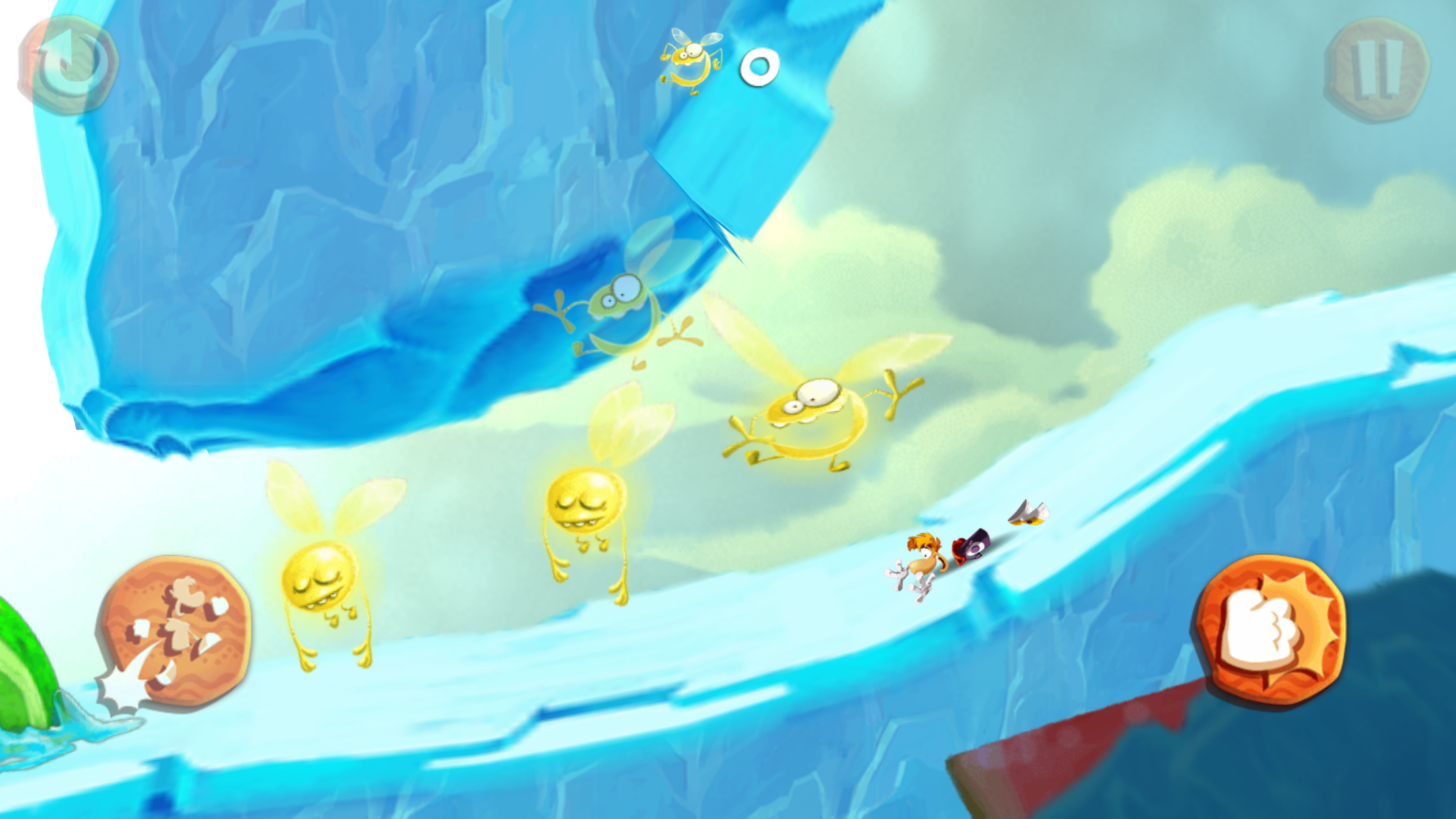
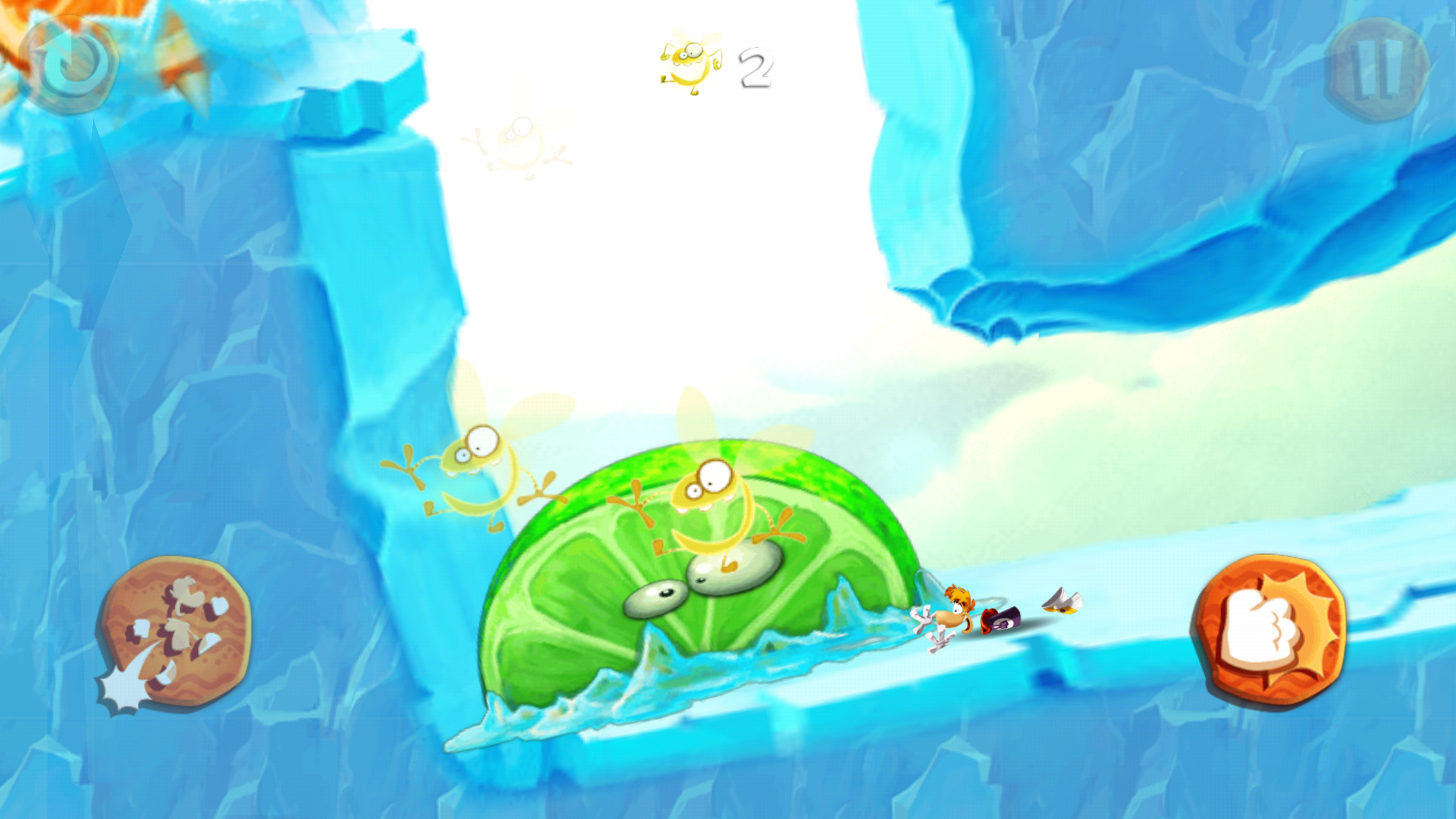
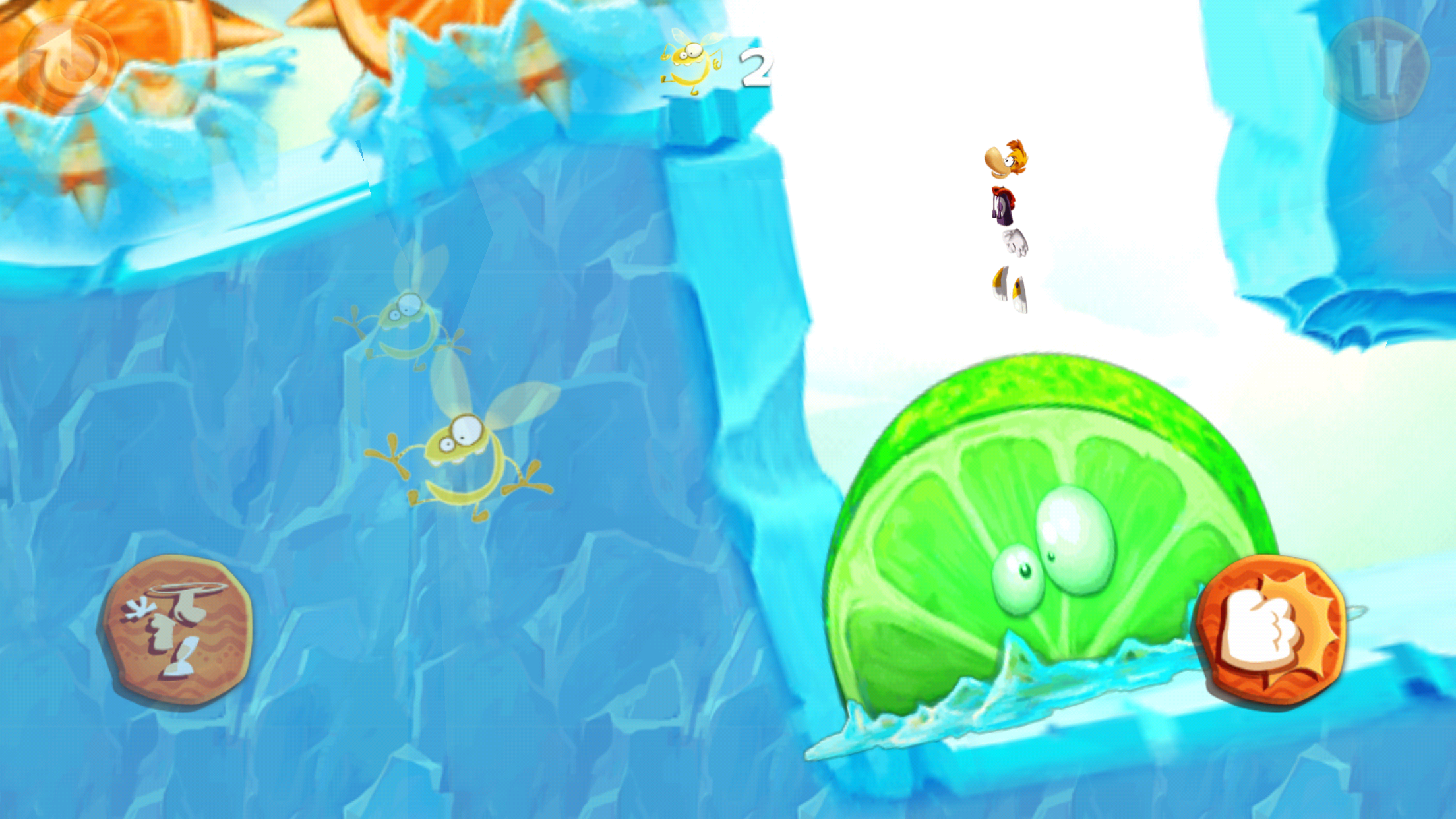
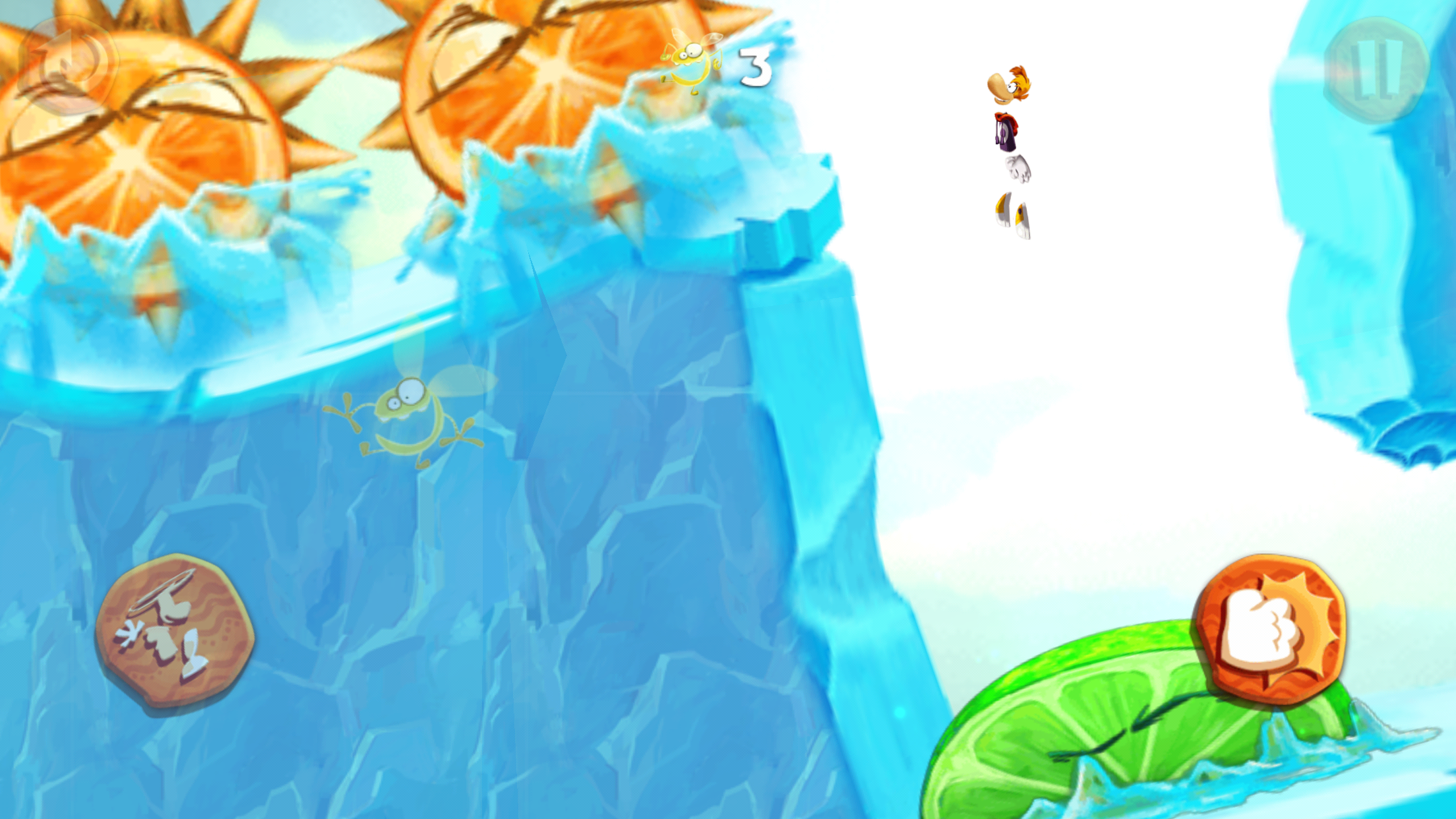
· Controls – We can see the jump button on the left side of the screen and the punch on the right. I can’t tell you how many mobile games make the mistake of only having the button image be an input. This causes problems due to the precision needed to hit these buttons. (Unlike controllers, your finger can move on a flat screen and doesn’t have the feedback of touching an actual button so they are easy to miss, but that’s for another time) Not a problem here! The entire left side of the screen is the jump button. The right side of the screen is for punching.
· The Yoshi’s Wooly World Effect – In Yoshi’s Wooly World, it is perfectly possible to beat the story levels without collecting everything in the game. And it isn’t a particularly difficult game. The difficulty skyrockets when the player decides to be a completionist. Rayman does the exact same thing. The levels aren’t particularly tough but, if the player wishes to collect all the Lums, the difficulty level spikes. God forbid collecting all of the Lums on the difficult series of levels.
The “Free”-to-play:
Technically, the game isn’t free to play. Generally, it costs $2.99 to download. Then, on top of that, the players have the option within the game to spend additional real life money. Before you grab your pitchforks and torches, the in-game purchases are completely optional. They are entirely to speed up progression or just for fun. The three different purchasable items, via Lums, are:
· Permanent power ups
· Art images
· Characters
There is an additional purchasable item, but I’ve never thought much about it because I haven’t had any trouble obtaining them. Those are Lums. Because the player can collect up to 100 Lums per level completed, I’ve never had any issue where I had to buy them. They feel strictly like if the player wishes to have a whole bunch of them very quickly they can buy them, but it isn’t needed.
Side note: This is exactly the mentality we want players to have in a free to play game. This keeps them from getting mad at the company for attempting to make some money. It also makes them more likely to actually purchase items because they are feeling happy and more trusting of the developers.
Earlier, I mentioned that there were upsells, but the players never noticed them. You might think, what the heck? How is this possible?
That’s how. After the player has lost at least ten times in a row, before trying again they are upsold a power up. Now this power up is upsold through using in game currency, which is plentiful. Because it seems so plentiful, players don’t mind buying the power up. There is no button asking for money, and the language seems to be more suggesting help rather than “HEY YOU SUCK AND NEED TO BUY HELP”. The look of the heart definitely helps as well. (Derp faces can’t be taken seriously. The Charm is literally hiding the upsell.) Now, this particular power up costs 80 Lums. The player can only ever receive a max of 100 Lums for each level completion. So what the player doesn’t think about is that one power up costs nearly a whole perfect run. And this is one of the cheapest power ups, most are much more expensive. (the highest being 200 Lums)
As you can tell from some of my images, I have over 4,000 Lums at the moment. Five levels ago, I had 1,000 more. The difficulty balancing of later levels nudges the player to use power ups to do better and complete the levels. This slowly drains the Lums as the player chooses to use the power ups. They are not feeling pressured by the game to use them because it is their own drive pushing them to do better. (Essentially they are not doing so well and need help, so they pay for it) All the power ups have a purpose and feel useful. (My go to team is the Magnet, Too Much Help, and the Golden Heart. Every time I do this, I spend 440 Lums without giving it a second thought. That is four and a half perfect runs.) And it works. When I run into a level which is particularly difficult, I’ll try a few times and if I get stuck, I’ll pop one or two power ups. Mostly, the ones I use help me collect all the Lums in the level, where as the other power ups are typically helpful just to get to the end.
Side note/Soap Box: While writing this post it got me thinking. Typically, in free-to-play games we have two kinds of currency, gold – found in game, and gems – premium currency bought with real money. I can’t help but wonder if the lack of gems in this game is helping them to have a more positive response. Because there is only the one currency and it is so plentiful in the game, (By plentiful I mean I understand how to get a decent amount of it using my skill) perhaps this is contributing to the feeling of not being nickeled and dimed. Yes, I can buy Lums if I so choose, or I can put the time in to make the money in game. Where as something like gems are only available through buying them (or getting one or two for a daily reward). Additionally, in other games some content will be locked behind paywalls which require gems. Thus the player is getting more annoyed over time due to the fact that the developers are asking for “more” money later on. In Rayman it doesn’t ask for money, the player has to navigate to the store if they wish to spend real world cash. Thus the player is making a conscious decision to go there and take a look at the products. They aren’t having it shoved in their face.
An analogy if you will:
The way Rayman does shopping is more akin to going to Target and looking around. You have chosen to go to this location and engage in shopping or just looking around. Maybe you will get a flyer in the mail (the incredibly passive upsell in Rayman.) but they don’t do a lot to annoy you. Because you chose to expose yourself to the advertisements and products you will have a better time. Most upsells in games are like your cable company calling you trying to sell you better cable. The first time you are courteous and politely decline. After the fourteenth time…. Not so much. And the way we typically do upsells it would be during every commercial break, while we are watching T.V. While they position it strategically to not directly interrupt us. It still gets annoying when constantly asked.
This bleeds over a little bit into ads as well. Most ads in games are more like telemarketers or door to door salesmen. You’re minding your own business at home, watching the newest episode of Game of Thrones and someone bangs at your door. “Hello sir or Madame? Would you like to purchase a vacuum?”. The interruption is mildly annoying the first time. But if new salesmen keep showing up the annoyance just builds. Until you are frustrated and start to yell at they poor guy trying to make a living. Thus angry comments.
But Scott wouldn’t you go into these games knowing that you will get ads/upsold products? I mean it is common knowledge by now.
This is a valid point. It might be more like watching the Walking Dead then and having commercial breaks. But with technology these days more and more people are avoiding commercials all together. Ad blockers for the web. DVRs allow people to fast forward through commercials during their favorite shows. Heck, I just use Netflix for most of my shows now a-days. No commercials. People don’t like to be interrupted when consuming media. But we need to interrupt them with ads to make a profit or we can’t create new media. So we need to find ways to make their interruptions subtler. Or even passive so we don’t force them from their immersive experience.
Personally, I’m a big fan of subtly. Like how all the Transformers, in Michael Bay’s films, are GMC vehicles. It’s subtle and unobstructive to the player’s engagement. Upsells are a little trickier. I can’t tell you for sure what works perfectly every time. But I can tell you what pisses players off the most: Locking content behind paywalls and feeling like the items being upsold are necessary. Specifically, as far as paywalls go, ones which require real world money. If you want to use in game currency to halt a player’s progression, we know this doesn’t piss them off. Countless games have done it without a problem. But real world pay walls piss players off more than anything. For the items being upsold they must not be necessary. By this, I mean the player must not believe they are necessary to progress. In Angry Birds 2 there was more than once where I felt I required an item in order to beat the level. This is the worst thing you can do to a player. It ejects them from the immersion and the fun of the experience. It’s up to the Designers to make sure the gameplay feels balanced so the items being upsold enhance the gameplay or simply speed it up. We don’t want players to think it is necessary. (Clash of Clans does this expertly with speeding up building construction) And with that I’m stepping off my soap box and continuing on with this analysis.
The “Eh, that could be better”:
· The music: Now, the music is not actually bad. It’s charming like the rest of the game. The issue here comes from working on a mobile device. Because they chose not to use a loader (You know how when you boot up Angry Birds 2 it takes a few minutes to download new assets from the internet? Yeah, that.), they have a limited amount of memory to work with. This doesn’t allow the designers to have as many options. Let me elaborate, in Rayman Legends (2013), in the music levels the player’s jump and attacks are timed with the beat of the music. (I can try to explain it all day but it will be better if I show you:
And while I understand it is almost definitely a different team, other people might not. Due to them making the game for mobile, they have a very limited amount of memory to work with (#mobileDeveloperProblems), or may not have the resources to do it. So they are restricted to using the same five songs over and over again and can’t pull off precision experiences like the one in the video.
Side note: At this time, I would like to acknowledge that it was obviously not the chosen direction to go with due to multiple reasons. And I completely respect that. The game is fantastic already as it is. I’m just saying, I think, it could have been even cooler. People who have not experienced Rayman Legends won’t have this problem because they wont know this exists. But I know this amazing experience exists and I wish they could do something on that level.
Side SIDE note: I do give them credit for not using a loader. It gets the player in and out of the game much faster. It makes the game feel smoother and I love not having to wait 2 minutes to start playing. This, aside from the fact that it is a really solid game, contributes to me hopping in so often.
Hopefully, I got you thinking about how to hide upsells and how to make players feel like nobody is attempting to make any money off of them, even though we are. I know they aren’t glamorous topics, but as mobile developers we have to use them. So why not use them in a way which doesn’t annoy players and makes sure they have as much fun as possible, while we still profit.
Rayman Fiesta Run is a fantastic runner with a lot of charm. The levels are incredibly clever and I suggest you try some of them out for yourself. I would love to discuss them with you in the comments if you’ll join me. This post almost was a look into a few levels and how they taught the player skills just by putting new obstacles in their way. But the hidden upsell really stood out to me. Maybe, if I have a little more time, I’ll do a bonus post this week going over the first level. We’ll see.
Next week we’ll be trying something completely different, I’m going to be getting back out there and showing off a prototype. I created a paper prototype a few weeks back and figured it might be fun to bring it into the digital world. I look forward to sharing that with you.
I’ll see you guys next week,
Scott
If you like my work and want to support my caffeine addiction, please consider donating to my Ko-Fi.



























